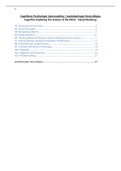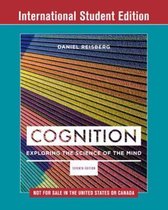Summary
Summary Cognitive Psychology + lecture notes, ISBN: 9780393665093 Cognitive Psychology (PSBA2-23)
- Course
- Institution
- Book
This document summarizes chapters 1, 3 to 10, 12 & 13 of the book Cognition - Daniel Reisberg. It also contains the lecture notes for the school year 2021/2022. It has also some dutch words/phrases.
[Show more]





